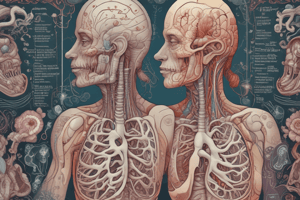Podcast
Questions and Answers
What is the main function of the diaphragm in the human body?
What is the main function of the diaphragm in the human body?
- To separate the abdominal cavity and the thoracic cavity
- To facilitate inhalation (correct)
- To facilitate exhalation
- To control the breathing rhythm
Which of the following statements is true about ventilation?
Which of the following statements is true about ventilation?
- It occurs by positive pressure breathing
- It occurs by negative pressure breathing (correct)
- It occurs by a combination of positive and negative pressure breathing
- It is controlled by the diaphragm
What happens to the rib cage during inhalation?
What happens to the rib cage during inhalation?
- It expands, increasing chest cavity volume (correct)
- It moves downwards
- It decreases in size
- It remains the same
What is the role of the medulla oblongata in breathing?
What is the role of the medulla oblongata in breathing?
What happens to the pH of the cerebrospinal fluid when CO2 rises?
What happens to the pH of the cerebrospinal fluid when CO2 rises?
What is the function of hemoglobin in the blood?
What is the function of hemoglobin in the blood?
How many molecules of oxygen can each hemoglobin molecule carry?
How many molecules of oxygen can each hemoglobin molecule carry?
What is the role of hemoglobin in buffering blood?
What is the role of hemoglobin in buffering blood?
What is the primary function of the respiratory system?
What is the primary function of the respiratory system?
What is the term for the process of gas exchange between the body and the environment?
What is the term for the process of gas exchange between the body and the environment?
Which part of the respiratory system contains the vocal cords?
Which part of the respiratory system contains the vocal cords?
What is the purpose of the rings of cartilage in the trachea?
What is the purpose of the rings of cartilage in the trachea?
Where does gas exchange occur in the respiratory system?
Where does gas exchange occur in the respiratory system?
What is the term for the tiny grape-like clusters of air sacs where gas exchange occurs?
What is the term for the tiny grape-like clusters of air sacs where gas exchange occurs?
What is the purpose of the nasal cavity in the respiratory system?
What is the purpose of the nasal cavity in the respiratory system?
What is the term for the movement of oxygen from the lungs to the body's tissues?
What is the term for the movement of oxygen from the lungs to the body's tissues?
Flashcards are hidden until you start studying
Study Notes
Gas Exchange in Humans
- Gas exchange involves breathing, transport of gases, and exchange with body cells to provide oxygen for cellular respiration and remove waste CO2.
- The process involves inhalation, transport, and exchange of gases between the environment and body cells.
Pathway of Air
- Air enters the respiratory system through the nostrils, where it is filtered, warmed, and humidified in the nasal cavity.
- Air then passes through the pharynx, a common passageway for air and food, and into the larynx, which contains vocal cords.
- The trachea, a tube with cartilage rings, leads to the bronchi, which branch into smaller bronchioles that eventually dead-end into alveoli, tiny grape-like clusters of air sacs.
Gas Exchange in Alveoli
- Alveoli are surrounded by blood capillaries, where gas exchange occurs through diffusion.
- Oxygen diffuses into the blood and carbon dioxide diffuses out of the blood into the alveoli.
Ventilation by Negative Pressure Breathing
- Ventilation occurs through negative pressure breathing, which creates a pressure gradient by changing the volume of the lungs.
- During inhalation, the diaphragm contracts, the rib cage expands, and air moves in due to the decrease in air pressure inside the lungs.
- During exhalation, the diaphragm relaxes, the rib cage gets smaller, and air pressure increases, pushing air out of the lungs.
Control of Breathing
- Breathing is controlled by involuntary mechanisms, with the medulla oblongata in the brain regulating breathing rhythm.
- Sensors in the medulla monitor the pH of cerebrospinal fluid, responding to changes in CO2 levels.
- When CO2 levels rise, the medulla increases breathing rate and depth to eliminate excess CO2 and maintain homeostasis.
Hemoglobin and Gas Transport
- Hemoglobin, an iron-containing pigment in red blood cells, carries oxygen and helps transport carbon dioxide.
- Each hemoglobin molecule can bind to four oxygen molecules, which bind to the four iron atoms.
- Hemoglobin also helps buffer the blood by binding to excess hydrogen ions.
Studying That Suits You
Use AI to generate personalized quizzes and flashcards to suit your learning preferences.



